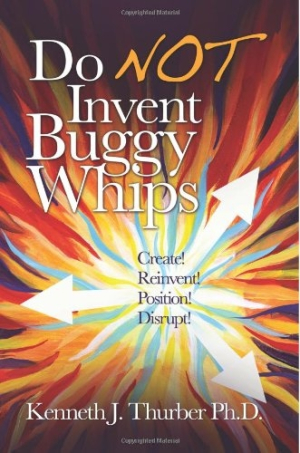Do NOT Invent Buggy Whips Create! Reinvent! Position! Disrupt!
Kenneth Thurber’s Do Not Invent Buggy Whips is all about how to create “a big wave,” as the author calls it. Thurber explains in his preface that while buggy whips were long a key component of transportation, the buggy whip industry failed to reinvent itself when the automobile came along.
Reinvention is a major theme of Thurber’s intriguing premise, but there are other elements that are equally important to his product-development philosophy. In part one of his book, Thurber discusses the origins of ideas and the concepts of innovation and reinvention. This section offers only cursory overviews, but it sets the tone for the rest of the book. Part two presents the author’s “Model for Disruption,” which is essentially a methodology for developing a new product. Here, the author walks the reader through each part of his model: Position (including products, services, and components), Customer (including prospects, early adopters, consumers, and repeat buyers), and Reinvent (including new capabilities, benefits, and features). This model is the core concept of the remainder of the book.
Part three demonstrates how the model can be applied. Part four, however, will probably be of most interest to the reader. In it, Thurber includes ten case studies of products that used reinvention, both successes and failures. It is particularly enlightening to read Thurber’s interpretation of Apple’s wildly successful iPod, a reinvention of a portable music device, in contrast to his take on the failed Segway, a two-wheeled vehicle created in an attempt to reinvent a mode of transportation.
The book’s final section, part five, explains the author’s views on “future disruption.” Thurber concludes that the “way to develop new products and build successful companies is to embrace change and to be the person who causes disruption … You should seek disruption as a way to ensure your future because not seeking to create innovation and disruption will doom you to living in the past.”
Do Not Invent Buggy Whips is a useful primer on innovation. It does, however, cover ground that is not entirely new. Numerous books have been written about disruptive innovation in far greater detail, from The Innovator’s Dilemma, by Clayton Christensen in 2003, to The Innovator’s Guide to Growth, by Scott Anthony, Mark Johnson, Joseph Sinfield, and Elizabeth Altman in 2008. Still, if the reader is seeking a quick overview of a product-development process with an emphasis on reinvention, Thurber’s book adequately fits the bill.
Reviewed by
Barry Silverstein
Disclosure: This article is not an endorsement, but a review. The publisher of this book provided free copies of the book and paid a small fee to have their book reviewed by a professional reviewer. Foreword Reviews and Clarion Reviews make no guarantee that the publisher will receive a positive review. Foreword Magazine, Inc. is disclosing this in accordance with the Federal Trade Commission’s 16 CFR, Part 255.

